AFM Systems
AFM Accessories
Learning
Contact Us
With the introduction of blueDrive in 2013, Oxford Instruments Asylum Research pioneered photothermal excitation in commercially available AFMs. With an installed base of hundreds of blueDrive AFM systems, no one understands the advantages of photothermal excitation better than Asylum Research and our customers.
No matter what your field of research or industry may be, blueDrive makes all tapping mode techniques simpler, more stable, and more accurate. This page describes blueDrive photothermal excitation, its capabilities, and benefits.
Get information from an AFM expert
Tapping mode is by far the most used AFM imaging mode. That is because it provides the highest resolution, the fastest results, it is gentle on samples, and it can measure not just topography, but also mechanical, electrical, and magnetic properties of samples. But not all implementations of tapping mode are created equal. Asylum’s blueDrive excitation technique uses a laser to directly excite the cantilever resonance, making tapping mode simpler, more stable, and more quantitative.
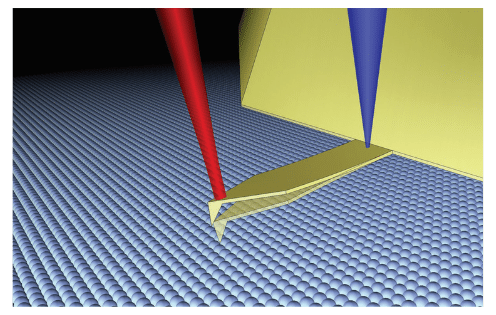
Schematic representation of the blueDrive laser (blue) and the detection laser (red) placement on the cantilever.
This animation shows how modulating the blueDrive laser results in cantilever deflection.
Most AFMs place a piezo near the cantilever and use it to mechanically drive the cantilever oscillation that is required for tapping mode, a technique known as piezoacoustic excitation. While this approach is often favored for design simplicity, the resulting response is far from ideal. The piezo shakes the whole AFM, exciting spurious mechanical resonances that couple into the cantilever response, resulting in a “forest of peaks”. The consequences go far beyond just an ugly cantilever tune. Piezoelectric excitation makes tapping mode more difficult to setup, makes it more difficult to maintain stable, high-resolution imaging, and interferes with quantitative analysis of the cantilever oscillation that is required for nanomechanical and nanoelectrical imaging modes.
Asylum’s blueDrive photothermal excitation technique replaces the tapping piezo with a laser that is focused on the base of the cantilever. Its power is modulated at the desired drive frequency, exciting the cantilever oscillation photothermally. Because it only interacts with the cantilever, no other resonances are excited. The result is an exceptionally clean and stable cantilever response that matches nearly perfectly with the predicted theoretical response, whether one is operating in air or in liquid. No other tapping mode implementation can compare.
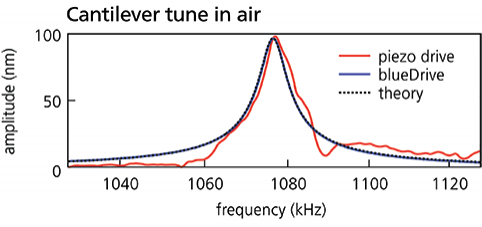


Lipid bilayers consisting of 50:50 DOPC and DPPC were deposited on mica and imaged in water using blueDrive photothermal excitation and tapping mode on a Cypher S AFM. Image size 3 µm.
One of the biggest advantages of atomic force microscopy is that samples and processes can be visualized in a wide variety of environments. For biological samples, this usually means imaging in water or aqueous buffer solutions. But imaging in liquids has historically been one of the most challenging use cases for tapping mode AFM. Not only is cantilever tuning complicated by the “forest of peaks,” but it can also be difficult to achieve and maintain stable, high-resolution imaging.
The benefits of using blueDrive photothermal excitation in liquid environment are immense. blueDrive directly excites only the cantilever, so the cantilever resonance peak in liquid is just a clean, clear, and easy to tune as what you see in air. Not only that, but the response stays stable for many hours, even as liquids are perfused or the temperature changes. This makes it simple to maintain stable high-resolution imaging.

DNA molecule on mica, in buffer. Acquired in tapping mode on a Jupiter using blueDrive. Image size: 500 nm.

DNA molecule on mica, in buffer. Red arrows show the spacing between three turns of the DNA helix; the green and gold arrows indicate the major and minor grooves, respectively. Acquired in tapping mode on Cypher ES using blueDrive. Image size: 65 nm.
Capturing nanoscale dynamic processes can be difficult because imaging needs to remain stable over a long period, sometimes under challenging conditions that include temperature changes and fluid perfusion. Unlike the shifting forest of peaks produced by piezoacoustic excitation, the photothermal drive response remains constant with time irrespective of the fluid volume and temperature changes. This enables uninterrupted imaging for the entire length of experiments, even during continuous fluid perfusion, as shown in the calcite screw dislocation experiment below.
Studying battery materials and other electrochemical processes is another situation where experiments take place under difficult conditions such as liquid volume changes.. Combining blueDrive with an electrochemistry cell makes the AFM a valuable tool for real-time monitoring of electrochemically driven processes. The figure below shows an example of in situ monitoring of copper crystal growth on a Cypher ES AFM. Crystals were first deposited from an acidic aqueous solution of copper sulfate and were then stripped away by changing the potential of a gold electrode.

Small cantilevers are essential to high-speed AFM. But the same characteristic that enables faster scanning and lower noise, namely their very high resonance frequencies, also makes them more difficult to drive with piezoacoustic excitation. Tunes are more likely to show severe distortions and to be highly variable in time, making setup and stable operation more complicated.
In contrast, blueDrive photothermal excitation provides a clean, stable response at high frequencies, making video-rate imaging much simpler. The response remains constant with time in liquid, even during perfusion experiments. This helps enables a wide range of video-rate AFM experiments, such as the ones featured below: biomolecular reactions, molecular self-assembly, and dynamics in surfactant films.
Several techniques involving dynamic modes have been recently developed for mapping of both elastic and viscoelastic properties. Although often adequate for basic imaging in air, piezoacoustic excitation is more problematic for nanomechanical mapping. Even in air, the cantilever response with piezoacoustic excitation contains both on- and off-resonance distortions. An insufficiently flat drive response makes it difficult to evaluate whether changes in the cantilever response are due to sample properties or drive artifacts. This can cause errors in the results from model-based quantitative analysis and create tracking instabilities. Using photothermal excitation, however, the cantilever response possesses a nearly perfect resonance peak and is otherwise flat in frequency. As a result, measurements agree more closely with theoretical predictions, leading to less uncertainty in modulus calculations and improved accuracy.
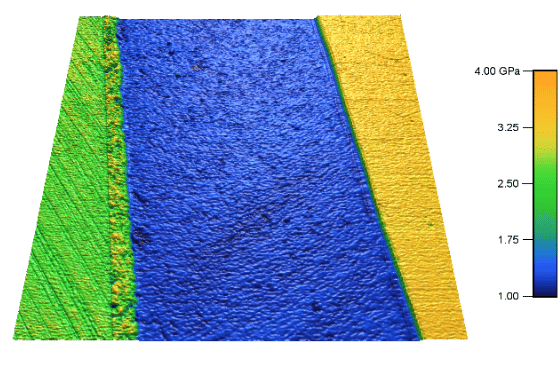
Nanomechanical map of a multilayer polymer composite viewed in cross section. Elastic modulus measurement is shown overlaid on a topography image: polyethylene terephthalate (green), polyethylene (blue), and ethylene vinyl alcohol (yellow). Acquired in AM-FM Viscoelastic Mapping mode on the Cypher S using blueDrive. Image size: 9 μm.
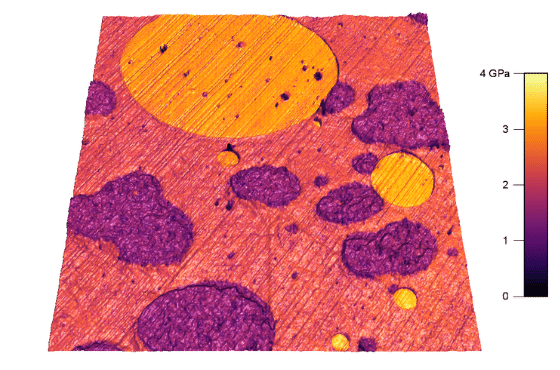
Elastic modulus overlay on topography of a polymer blend sample composed of polyethylene (darkest), polypropylene (matrix) and polystyrene (brightest). Acquired in AM-FM Viscoelastic Mapping mode on the Jupiter using blueDrive. Image size: 25 μm.
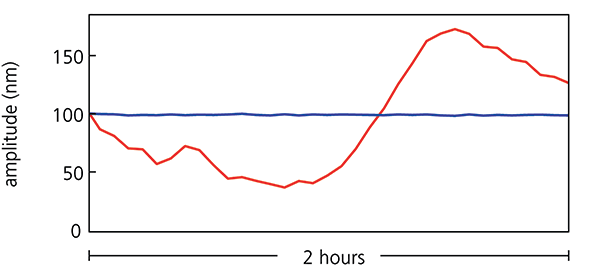
Comparison of cantilever amplitude stability over time using piezo drive (red) and blueDrive (blue). Performed on a Cypher AFM, 2 hours long experiment.
Stable imaging is not only important for video-rate AFM and other examples of dynamic processes. If the cantilever oscillation amplitude drifts over time, damage to the tip, the sample, or both, are likely to occur. Unfortunately, this drift can be concealed by the imaging feedback loop right up to the point where damage has already occurred. Many cases of poor imaging resolution or inconsistent results may be attributed to the poor stability of tapping mode using piezoacoustic excitation.
The direct excitation provided by blueDrive is highly immune to drift in the cantilever response, as shown in the graph here. Slight temperature variations or changes in the fluid volume cause the amplitude response to change over time when using piezo excitation. However, blueDrive keeps the amplitude stable even during fluid heating and fluid perfusion, which maintains high quality imaging without any user adjustments.
Since the cantilever amplitude remains stable throughout the experiment, the imaging force is kept constant which, in turn, preserves tip sharpness and sample integrity. Imaging is stable over extended durations with no need to readjust the amplitude setpoint such as demonstrated in the atomic resolution data of mica and silicon wafer surface roughness data shown below.
This application note focuses on examples that demonstrate the key benefits of blueDrive photothermal excitation such as simplified control, stable operation that's gentle on tips and samples, and improved quantitative results of nanomechanical AFM measurements.
Download the application note to learn:
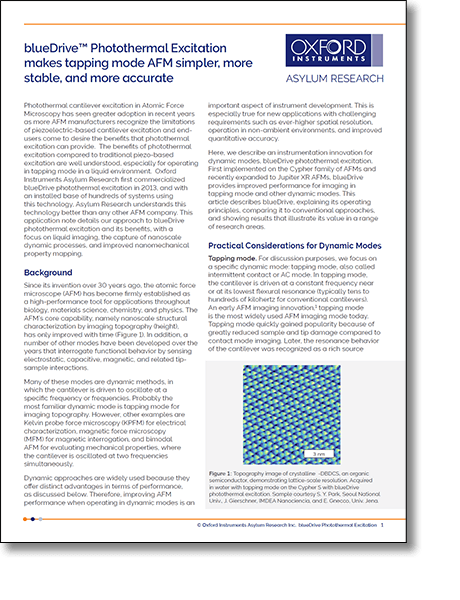
View more AFM images that have benefitted from blueDrive photothermal excitation in our image gallery!
See How blueDrive Can Improve Your Research
blueDrive is available on both the Cypher AFM Family and Jupiter AFM platforms. It is included on all Jupiter and Cypher VRS1250 systems and is available as an option on Cypher S and Cypher ES systems for both new and existing systems.
Contact us to discuss how blueDrive can help drive your research forward and to request pricing for either a new blueDrive-equipped AFM or a blueDrive upgrade.